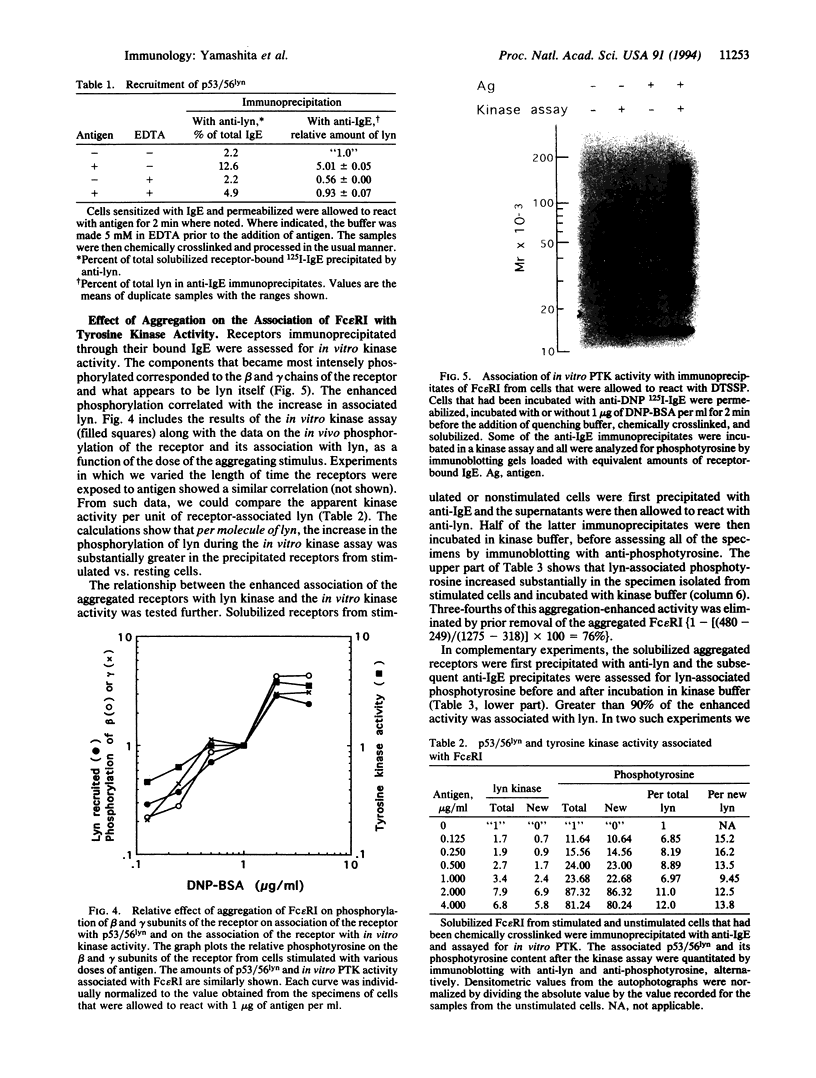Abstract
Aggregation of the receptor with high affinity for IgE (Fc epsilon RI) on the surface of mast cells and basophils stimulates phosphorylation of protein tyrosines, a process in which p53/56lyn kinase has been implicated. We measured the association between Fc epsilon RI and the kinase, using chemical crosslinking to stabilize their interaction. In the rat basophilic leukemia mast cell line, 3-4%, and at most 20%, of Fc epsilon RI appear to be associated with the kinase prior to aggregation, even though there is an excess of total cell lyn kinase. Aggregating the Fc epsilon RI causes three to four times more of the kinase to associate with receptors, a process requiring a prior phosphorylation step. In an in vitro assay, the lyn associated with the aggregated receptors becomes disproportionately more phosphorylated than would be predicted from the amount of lyn associated with the receptors. These and other data are consistent with a model in which aggregation of the receptor leads to its transphosphorylation by constitutively associated lyn kinase. We propose that additional molecules of this kinase are thereby recruited and that this markedly enhances transphosphorylation of tyrosine on the receptor and associated proteins, thereby initiating a cascade of further biochemical changes. This model is also consistent with data on receptors such as the clonotypic receptors on B and T lymphocytes, which share structural and functional features with Fc epsilon RI.
Full text
PDF




Images in this article
Selected References
These references are in PubMed. This may not be the complete list of references from this article.
- Benhamou M., Gutkind J. S., Robbins K. C., Siraganian R. P. Tyrosine phosphorylation coupled to IgE receptor-mediated signal transduction and histamine release. Proc Natl Acad Sci U S A. 1990 Jul;87(14):5327–5330. doi: 10.1073/pnas.87.14.5327. [DOI] [PMC free article] [PubMed] [Google Scholar]
- Benhamou M., Ryba N. J., Kihara H., Nishikata H., Siraganian R. P. Protein-tyrosine kinase p72syk in high affinity IgE receptor signaling. Identification as a component of pp72 and association with the receptor gamma chain after receptor aggregation. J Biol Chem. 1993 Nov 5;268(31):23318–23324. [PubMed] [Google Scholar]
- Benhamou M., Siraganian R. P. Protein-tyrosine phosphorylation: an essential component of Fc epsilon RI signaling. Immunol Today. 1992 Jun;13(6):195–197. doi: 10.1016/0167-5699(92)90152-w. [DOI] [PubMed] [Google Scholar]
- Blank U., Ra C., Miller L., White K., Metzger H., Kinet J. P. Complete structure and expression in transfected cells of high affinity IgE receptor. Nature. 1989 Jan 12;337(6203):187–189. doi: 10.1038/337187a0. [DOI] [PubMed] [Google Scholar]
- Clark M. R., Johnson S. A., Cambier J. C. Analysis of Ig-alpha-tyrosine kinase interaction reveals two levels of binding specificity and tyrosine phosphorylated Ig-alpha stimulation of Fyn activity. EMBO J. 1994 Apr 15;13(8):1911–1919. doi: 10.1002/j.1460-2075.1994.tb06460.x. [DOI] [PMC free article] [PubMed] [Google Scholar]
- Eiseman E., Bolen J. B. Engagement of the high-affinity IgE receptor activates src protein-related tyrosine kinases. Nature. 1992 Jan 2;355(6355):78–80. doi: 10.1038/355078a0. [DOI] [PubMed] [Google Scholar]
- Fewtrell C., Metzger H. Larger oligomers of IgE are more effective than dimers in stimulating rat basophilic leukemia cells. J Immunol. 1980 Aug;125(2):701–710. [PubMed] [Google Scholar]
- Holowka D., Metzger H. Further characterization of the beta-component of the receptor for immunoglobulin E. Mol Immunol. 1982 Feb;19(2):219–227. doi: 10.1016/0161-5890(82)90334-0. [DOI] [PubMed] [Google Scholar]
- Hutchcroft J. E., Geahlen R. L., Deanin G. G., Oliver J. M. Fc epsilon RI-mediated tyrosine phosphorylation and activation of the 72-kDa protein-tyrosine kinase, PTK72, in RBL-2H3 rat tumor mast cells. Proc Natl Acad Sci U S A. 1992 Oct 1;89(19):9107–9111. doi: 10.1073/pnas.89.19.9107. [DOI] [PMC free article] [PubMed] [Google Scholar]
- Kagey-Sobotka A., Dembo M., Goldstein B., Metzger H., Lichtenstein L. M. Qualitative characteristics of histamine release from human basophils by covalently cross-linked IgE. J Immunol. 1981 Dec;127(6):2285–2291. [PubMed] [Google Scholar]
- Keegan A. D., Paul W. E. Multichain immune recognition receptors: similarities in structure and signaling pathways. Immunol Today. 1992 Feb;13(2):63–68. doi: 10.1016/0167-5699(92)90136-U. [DOI] [PubMed] [Google Scholar]
- Kent U. M., Mao S. Y., Wofsy C., Goldstein B., Ross S., Metzger H. Dynamics of signal transduction after aggregation of cell-surface receptors: studies on the type I receptor for IgE. Proc Natl Acad Sci U S A. 1994 Apr 12;91(8):3087–3091. doi: 10.1073/pnas.91.8.3087. [DOI] [PMC free article] [PubMed] [Google Scholar]
- Paolini R., Jouvin M. H., Kinet J. P. Phosphorylation and dephosphorylation of the high-affinity receptor for immunoglobulin E immediately after receptor engagement and disengagement. Nature. 1991 Oct 31;353(6347):855–858. doi: 10.1038/353855a0. [DOI] [PubMed] [Google Scholar]
- Pleiman C. M., Abrams C., Gauen L. T., Bedzyk W., Jongstra J., Shaw A. S., Cambier J. C. Distinct p53/56lyn and p59fyn domains associate with nonphosphorylated and phosphorylated Ig-alpha. Proc Natl Acad Sci U S A. 1994 May 10;91(10):4268–4272. doi: 10.1073/pnas.91.10.4268. [DOI] [PMC free article] [PubMed] [Google Scholar]
- Pribluda V. S., Metzger H. Transmembrane signaling by the high-affinity IgE receptor on membrane preparations. Proc Natl Acad Sci U S A. 1992 Dec 1;89(23):11446–11450. doi: 10.1073/pnas.89.23.11446. [DOI] [PMC free article] [PubMed] [Google Scholar]
- Pribluda V. S., Pribluda C., Metzger H. Transphosphorylation as the mechanism by which the high-affinity receptor for IgE is phosphorylated upon aggregation. Proc Natl Acad Sci U S A. 1994 Nov 8;91(23):11246–11250. doi: 10.1073/pnas.91.23.11246. [DOI] [PMC free article] [PubMed] [Google Scholar]
- Segal D. M., Taurog J. D., Metzger H. Dimeric immunoglobulin E serves as a unit signal for mast cell degranulation. Proc Natl Acad Sci U S A. 1977 Jul;74(7):2993–2997. doi: 10.1073/pnas.74.7.2993. [DOI] [PMC free article] [PubMed] [Google Scholar]




